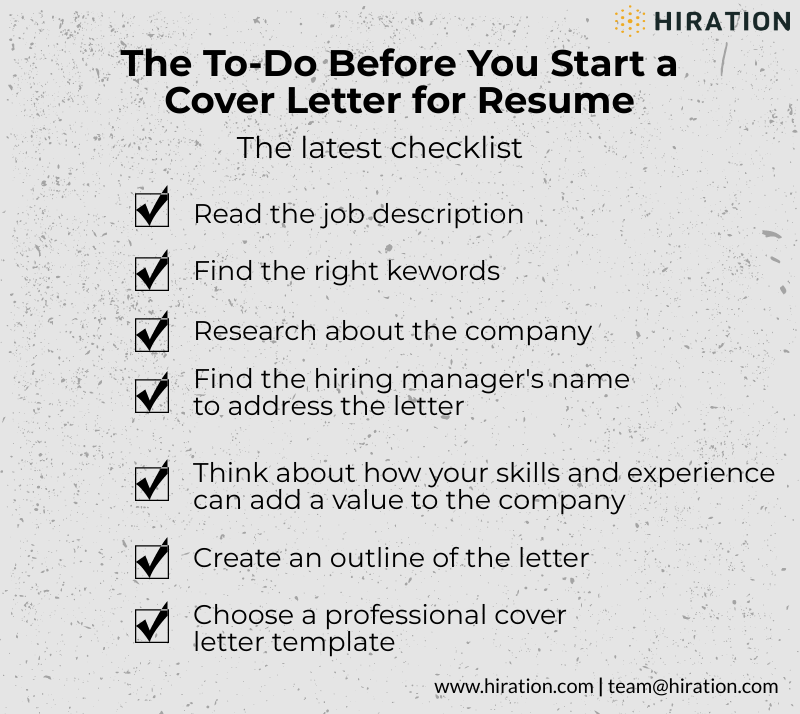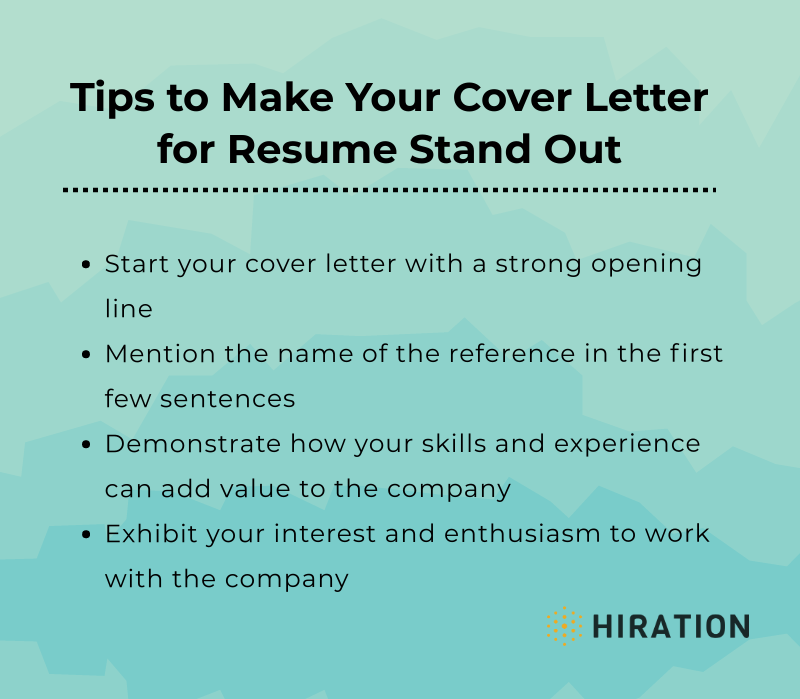How to write a cover letter for resume?
[Click here to directly go to the complete Cover Letter For Resume Sample]
A cover letter is a formal document that you attach with your resume while applying for a job application. It helps you convince the hiring manager why you are the right fit for the role you are applying for.
You can explicitly showcase your skills and experiences in the cover letter complementing the information you have mentioned in your resume.
Here are a few tips for you to write a cover letter for resume
- Understand the purpose of the cover letter to make the best use of the coveted space
- Read the to-do list before you start to write a cover letter
- Know the difference between cover letter and a resume
- Always use a professional cover letter template
Here's what you would find in this guide:
- What is a cover letter for resume?
- How to make a cover letter for resume?
- Cover letter vs Resume
- resume cover letter template
What is a Cover Letter for Resume
Both cover letter and resume are your marketing tools to make an impact on the hiring manager to secure the job application you are interested in.
It might seem unnecessary to write a cover letter thinking that you are already providing a resume with enough information. A cover letter is optional, but you must send it until a recruiter explicitly mentions not sending one.
The Purpose of a Cover Letter
- The coveted space allows you to demonstrate your skills, experience, and knowledge in a more personal and detailed way.
- It helps you cover the information you want the hiring manager to know about you, but you couldn't mention it in your resume.
- It helps you exemplify your ability to do the job and your enthusiasm to work for the company.
If you are not sending one, you are significantly reducing your chances of getting hired.
Writing a cover letter specific to every company you are applying for can be challenging, but it's essential to take the pain if you want to get the job.
Before you start to write a cover letter, make sure you do a proper research about the company. This will help you design your cover letter efficiently by mentioning your skills that you know the employer might be seeking and set a good impression.
How to Make a Cover Letter for Resume
A cover letter is usually a 3-4 paragraphs summary. Make sure you use this space to highlight how your skills and strengths align with the company's goals.
You can be direct and dynamic and explain why you would be a great addition to their team.
Long cover letters are often ignored, and I am sure you wouldn't want that to happen to your cover letter.
To-Do List Before You Start to Write a Cover Letter
- Read the job description carefully and find the right keywords for the job profile
- Do a good research about the company to understand it's goals and vision
- Research the hiring manager to address your cover letter to avoid sounding generic
- Make a list of how your skills and experience can add a value to the company
- Create an outline of the letter and Choose a professional cover letter template

Make your cover letter brief while including all the relevant points you feel are appropriate for the job position and the company. It should be short and straightforward enough for the hiring manager to read it at a glance.
Make Your Cover Letter Stand Out
- Start your cover letter with a strong opening line to catch the recruiter's attention at a first instance
- If you are referred by someone who works in the company, try to mention it in the first few sentences or two to create an impact
- Make it clear why you want the job position and why you are enthusiastic about working with the company.
- Do not go unreasonable with the flattery and avoid sounding desperate.

"When you don't get hired, it's usually not because of a lack of skills," says Gickman. "It's because people didn't believe your story, that you wanted the job, or that you knew what you were getting into."
Your cover letter must depict the best version of you that aligns with the company's goals and mission.
Cover Letter vs Resume
Your cover letter and resume help you make the first impression on the hiring manager in the entire hiring process. While both are equally important, but there is a difference between the two.
Both documents serve different purposes. Make sure you know the right sense of each so that you can get the maximum benefit out of it.
Difference Between Cover Letter and a Resume
- A resume proves your worth by concrete numbers, while a cover letter demonstrates your potential in a story form
- A resume summarizes your past professional experiences while your cover letter focuses on your future goals and visions.
- A cover letter is an additional opportunity for those who want to make a career change to explain to the recruiter why you are making the shift and what skills you hold for the position.
- Consider your cover letter as an opportunity to persuade the employer that you are the right fit for the position at hand.
In short, The resume itemizes your professional experience, education, skills, and other quantifiable information. While a cover letter highlights the qualifications, skills, and knowledge in a summary form to convince the employer that you are the person he is looking forward to hiring for the job position.
Hiration pro tip: Use numbers in your resume wherever possible and highlight it. You can mention the number of people you supervised, the percentage increase in sales, or, say, your efficiency and performance ratio in numbers.
Resume Cover Letter Template
Whether it is a resume or a cover letter, make sure to use a professional template for both purposes.
An excellent professional template provides a framework you can adapt for different jobs. It is crucial to use ATS-friendly professional designs to make your resume and cover letter to the hiring manager's table.
Use well-structured sections and formatting to have a professional-looking structure to make the first impression right.
If you wish to have your cover letter and resume to be professional designed with proper formatting and the right keywords, you can get in touch with us, and we would love to help you out.
We have 20+ ATS-friendly design templates, and you can choose any that your think might work best for the job you are applying for.
Get them in 15+ designs. We can also help you pick the right template to craft a job winner cover letter and resume.
Hiration can also help you prepare for an interview and boost your confidence with an extensive database of 20,000+ interview questions and sample answers for 150+ work profiles.
You can also avail yourself of our Resume Review Service, where you can upload your existing academic resume on our Online Resume Builder and get insight from professionals on what changes you can make in your resume to make it shortlist-worthy.
Key Takeaways
Here's a quick roundup of the Do's and Dont's of a cover letter for resume
- Have a strong opening sentence and clarify in the first or two why you are enthusiastic about working with the company and what you bring to the table.
- Be direct and dynamic and address how you can manage the challenges the employer is facing. This shows that you have adequate knowledge of the company.
- Be succinct- Write your cover letter in a maximum of 3-4 paragraphs so that the recruiter can read your letter at a glance.
- Don't go overboard with flattery or say anything that you don't mean.
- Last and most important, Don't use a generic cover letter. Customize each cover letter specific to the job position.
If you want to create a cover letter for a resume, go to Hiration Cover Letter Builder and select 20+ templates and create a professional cover letter for your resume all by yourself.
Go to Hiration career platform which has 24/7 chat support and get professional assistance with all your job & career-related queries. You can also write to us at support@hiration.com and we will make sure to reach out to you as soon as possible.



